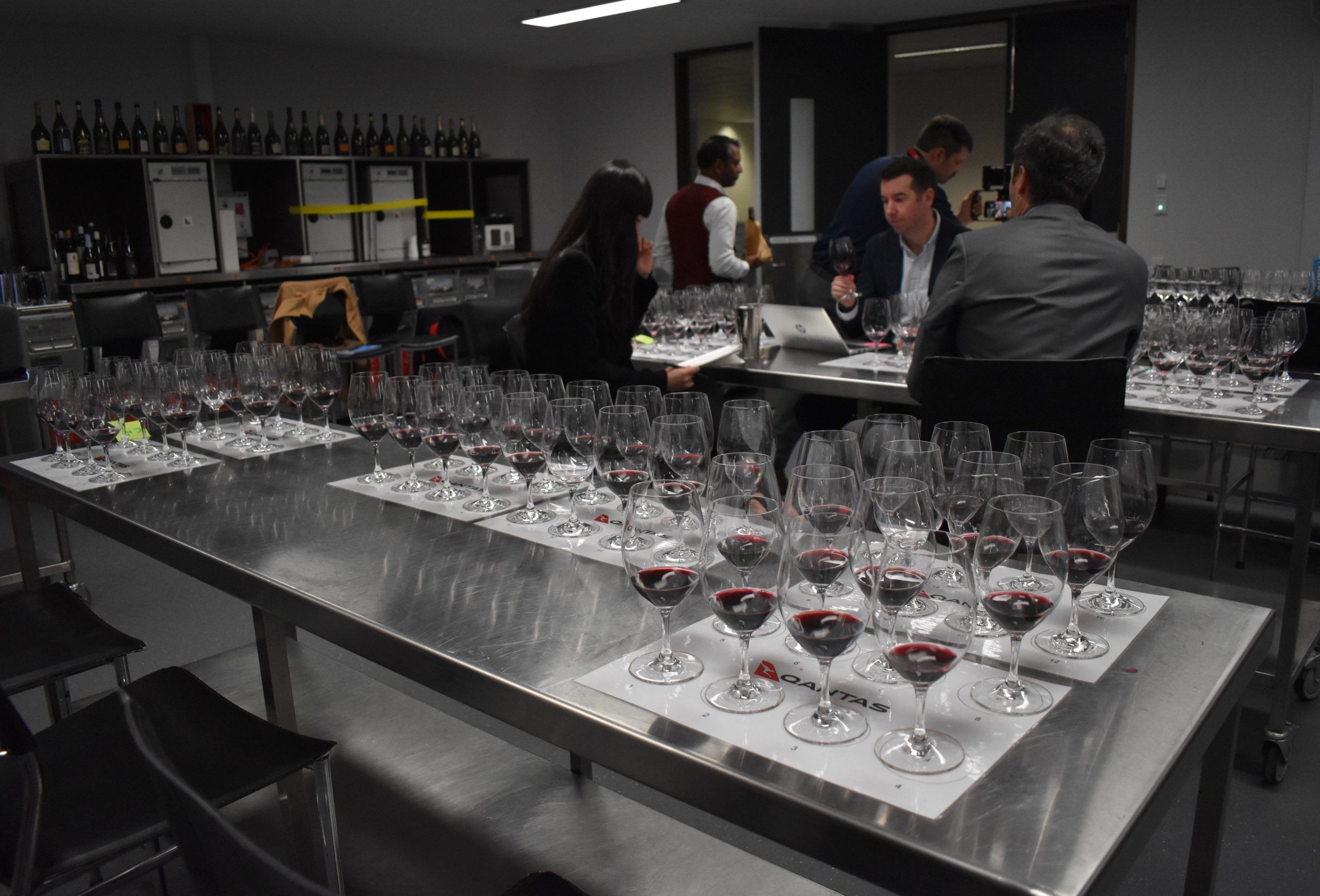Qantas Wine Week is a week-long event at the Qantas headquarters every year where a team of professional, hand-picked Qantas sommeliers sip their way through nearly 1,400 different wines. The list will eventually be narrowed down to the 300-400 labels that will be featured the following year in the airline’s first and business class cabins, as well as in Qantas-branded airport lounges around the world.
While we won’t be revealing which wines were selected or are even in the competition this year — as that remains confidential until the official unveiling in September or October — we did get a special invitation to the airline’s headquarters in Sydney, Australia, to get a behind-the-scenes look at the event, the inside of which is rarely seen by the general public. We also had the opportunity to interview the head sommelier and chairman of wine for Qantas Wine Week, Sebastian Crowtherand, and ask him some questions about the event. Any wine bottles in the photos you see have nothing to do with this year’s wine week and are past selections.
AirlineGeeks (AG): At the end of wine week, how many wines get chosen from the 1,400 that you start with?
Sebastian Crowtherand (SC): It varies every year, to be honest with you, but it’s in the hundreds; they need quite a significant amount of wine to be able to cater for all the correct aircrat for a 12-month period of time, it’s quite a lot.
(AG): So is it all Australian wine, or are you choosing products from other parts of the world as well?
(SC): Yeah, so one of the great things about Qantas is that they’ve always been a huge supporter of the Australian wine industry. So, actually, 99% of what’s flown on Qantas is Australian wine; the only exception to that is champagne, which you see served in the first and business class cabins.
(AG): Speaking of the 300 wines that you choose at the end of the week, obviously, there’s not going to be 300 types of wine on every flight. How do you choose what type of wine go on what flights? Is it based on the destination? Are you going to have a different selection on flights to Dallas than, say, London or Paris? How does it work?
(SC) : Yeah, there can be some differences and a few specific reasons as to why they choose certain wines. Like for instance, to New Zealand we sometimes have some New Zealand wines on board, and that can be kind of another one of the exceptions to the Australian wine focus that Qantas has. But typically, one of the logistical things is trying to get the right wines in the right places. With the limited amount of space they have on board, we try to work with key varieties, and in Australia, obviously, grapes like Shiraz and Cabernet for red are very important so you’ll see those on board, and for white wines, Riesling and Chardonnay are probably the two most common that we see there, but that’s not to say that occasionally there might not be Pinot Grigio, or Sauvignon Blanc, for instance. But you typically find those kinds of mainstays quite consistently.

- Qantas sommeliers tasting wines. (Photo: AirlineGeeks | Joey Gerardi)
(AG): I know this is a saying among people that, you know, drink not just wine, but alcohol on planes — ‘One on the ground is two in the air,’ and there’s a very big difference from drinking wine on the ground to when you’re drinking wine in the air in terms of not only the effect that it has on you, but the taste as well. How do you know what each wine is going to taste like here during Qantas Wine Week versus when you’re on the aircraft at 38,000 feet?
(SC): Yeah, I think there is a difference, and you know, it’s a difference in the wine and how the wine changes, but also a difference in how we perceive things and how our taste buds are affected by being at altitude and within a cabin. I think that probably the simplest way, and the way that I’ve sort of dealt with it over the years, is that we assume that whatever tastes good on the ground, tastes good in the air, and so there may well be changes in the way that we perceive things or the way that the white wine presents, but we still think it’ll be just as delicious, based on those changes.
(AG): Are there any wines that you reuse from year to year? Or once you use it for one year, you try not to use it the following year?
(SC): No, we definitely don’t have that philosophy; every wine will go through the tasting process, so there’s no guarantee that one wine from one year will be selected for the following year. We do find that some wines consistently end up on the final list, highly respected brands that have been around for a long period of time with strong reputations and great wine-making teams, and so they just have a way of producing wines in a very consistent manner through vintage variation. But you know, we always see small producers coming in every year, which adds some diversity to the landscape, and that always makes it interesting.
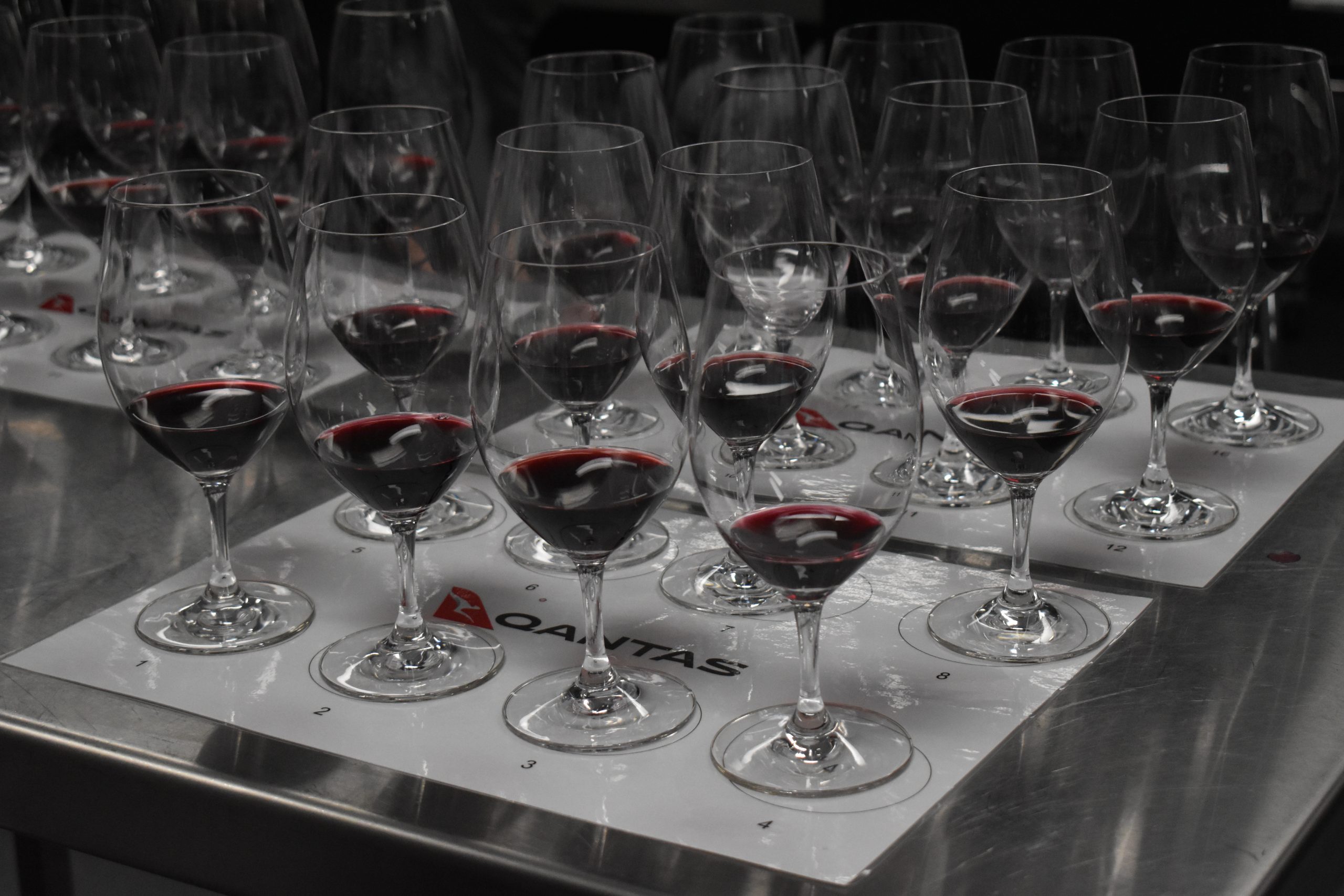
- A grouping of different red wines. (Photo: AirlineGeeks | Joey Gerardi)
(AG): Going from 1,400 to 300 is a big jump, but there are definitely more than 1,400 types of wine in the world. How do you go from the thousands that exist to the 1,400?
(SC): We send out a form to all the different producers around Australia, and we allow them to submit, it’s really an open application. So it’s open to every winery, big or small, and it gives everyone an equal opportunity. One of the great things about Qantas has been, from the very beginning, that they don’t purchase wine in huge volumes, meaning they don’t purchase just one type of wine that’ll cater for all airlines across the globe. They’ve always had a strong philosophy in trying to work with small amounts as well, so while we might buy a bigger amount from a larger winery, we also have the ability to buy smaller amounts from smaller producers too, to support those wineries and let them shine. So yeah, it’s open to everyone to submit their wine, and it’s up to them ultimately whether they want to be a part of the process, and we tend to find that there are obviously a lot of wineries that submit their wines, which is good for us because we have to see such a diversity across all the regions of Australia. We see lots of stuff from Western Australia, from Tasmania, all the way across the mainland, and up the east coast as well.
(AG): So obviously you’re not drinking 1,400 bottles of wine. How does that process work?
(SC): Typically, we’ll taste over a hundred wines a day across the two panels that we have running at the same time. So it’s a lot of wine, and if you were drinking each of those wines, you wouldn’t be very coherent at the end of the day, so we spit. It doesn’t sound very glamorous, but we have a little spittoon next to us, we take a smell, and a taste of each of the wines, and then we spit the wine out. You’re still able to get a really great understanding of the wine, its flavors, tannins, acidity, and how it’s made. So it’s not just about the taste, it’s very much about the structure of the wine as well, what we call the structure, so that’s the tannin and the acidity, and that’s what ultimately makes it drinkable. If you have a wine that’s too tannic, it will taste bitter, and a wine without enough acidity will be a boring drink. So we look at all the components of the wine to try and make the right decision whilst remaining sober and coherent.
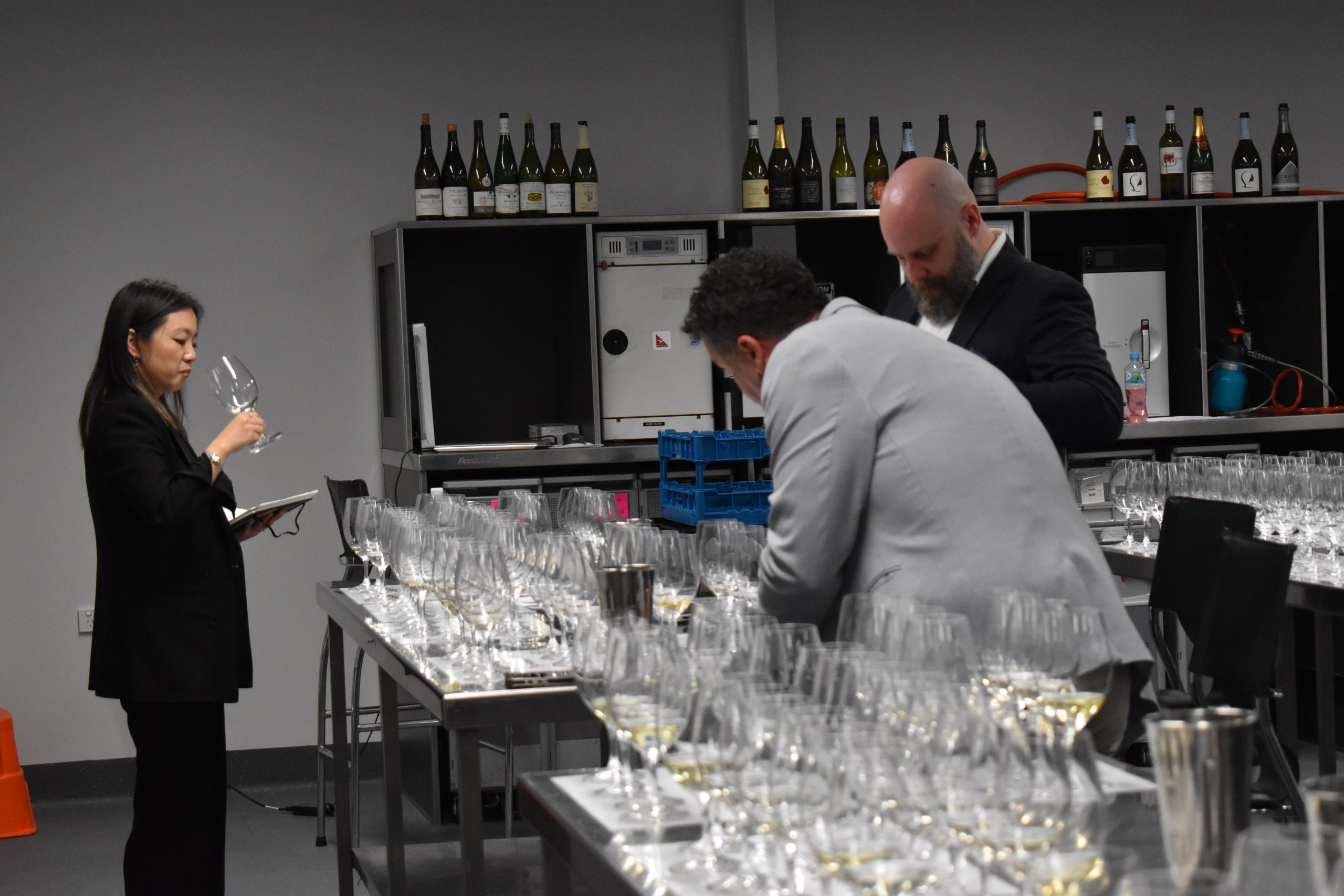
- Qantas sommeliers taste around 1,400 wines over the week. (Photo: AirlineGeeks | Joey Gerardi)
(AG): What does it take to become a sommelier for Qantas? Not only, you know, here during wine week, but just kind of overall for every year that you do this?
(SC): So a sommelier is, primarily, a person who works in a restaurant who buys wines. But within Qantas, they’ve developed a program which is called Sommeliers in the Sky, and that’s where hosts and hostesses can become qualified. Once they work in the business cabin, they go through a series of different levels where they get more and more education through that process, and in that, they will learn about all the different regions, not only in Australia, but internationally too, so that they understand the world of wine, not just wines domestically. And they’ll taste a lot of wine during that process too, comparing and contrasting different styles to get a really great understanding of the world.
(AG): So most of the sommeliers are flight crew then?
(SC): Yeah, there is a number of sommeliers that are here today who are flight staff, and so they’ve always been a great part of this process. And then we also have some sommeliers who get involved, who have worked in Neil Perry’s restaurants, who are in charge of the food, of course, as well as the wine. And myself, I worked with Neil in his restaurants for a long time, and I’ve continued on to do that now.
Inside the IOC
The Qantas Wine Week is certainly an interesting process and I’m glad we were able to ask some questions about it. However, Wine Week wasn’t the only exciting thing we had planned while we were at the airline’s headquarters. We also received a tour of the airline’s IOC, which stands for Integrated Operations Centre, and is the location where all of the planning takes place for every single Qantas flight in its system. It is truly a sight to behold with the computers and screens all around the room.
From the launching of their Kangaroo route in 1947, a multi-stop journey from Sydney to London, to inventing the business class cabin in the 1970s, and now leading the charge in ultra-long-haul flights with Project Sunrise — where it will operate the first ever scheduled nonstop from Sydney to both New York and London — the airline has truly been a leader in long-haul aviation innovation. Planning flights is always tough, and most of us in the aviation industry know that. It becomes even tougher when it is a long-haul route that spans thousands of miles. I had the opportunity to interview the head of the Integrated Operations Centre, Ben Holland, and ask him some questions.
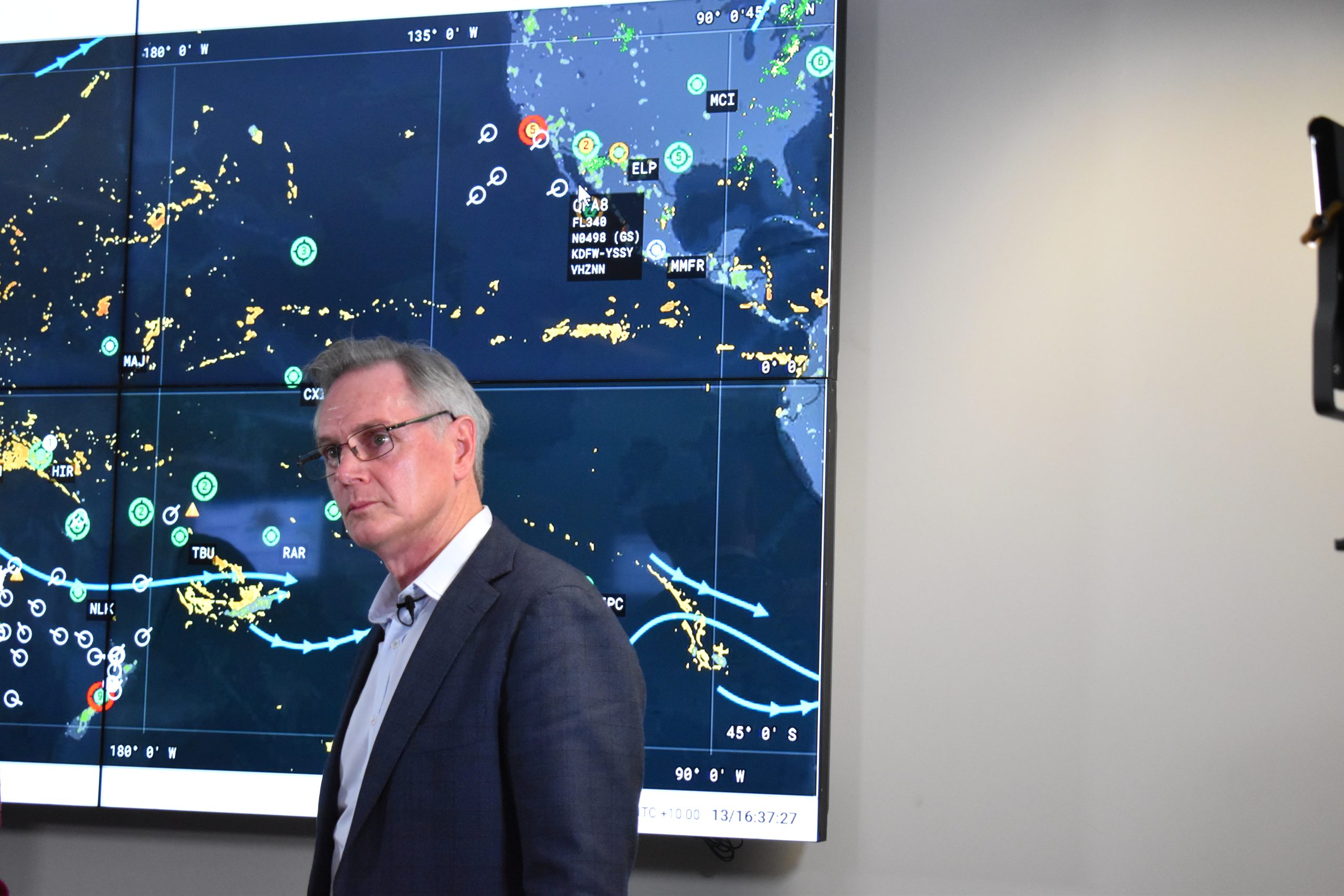
- Head of the Qantas IOC, Ben Holland, during our interview with him, and the flight map behind him. (Photo: AirlineGeeks | Joey Gerardi)
In parts of the interview, he was referring to the live flight map behind him. To see the flight map as well as the video interview, please see the video at the bottom of this article.
AirlineGeeks (AG): What goes into planning an international flight, given, you know, the many regulations and the no-fly zones around the world?
Ben Holland (BH): There’s an amazing amount that goes into planning an international flight. Have a look at the screen here, and you can see Australia. If you have a look at our comparison to the U.S., we’re a long way away, for instance, our Dallas service is around about 9,000 miles air distance from each other, and so there’s an amazing amount of work that goes into each and every day to plan each service. On the other side of things, about 9,000 miles the other direction is our Perth to London services, so this is something that we’re actually pretty used to, as this is the nature of our international operations.
(AG): You mentioned Dallas, that is your longest A380 route. But it’s also the second-longest A380 route in the world if I’m correct. What goes into planning a route like that, given it’s very close to the max range of that aircraft, especially with a full load of passengers?
(BH): So each day on a rolling basis, we’ll look at the next day’s operation. We’ve got a flight planning system that is best in world called Constellation, and we tailor that because of our long-range nature into having a look at the weather. So if you think, it’s a 17-hour journey, we need quite accurate forecasts a day out, 30 hours out, we also need to have a look at the on-route winds, and so we need to get really finesse levels of those winds, at the grid points, typically, you’ll lose one degree of latitude and one degree of longitude as a reference point for your wind, we’ll use .25 degrees of arrest at point, we walk 30 hours out and then we’ll refine that all the way up to the point of departure.
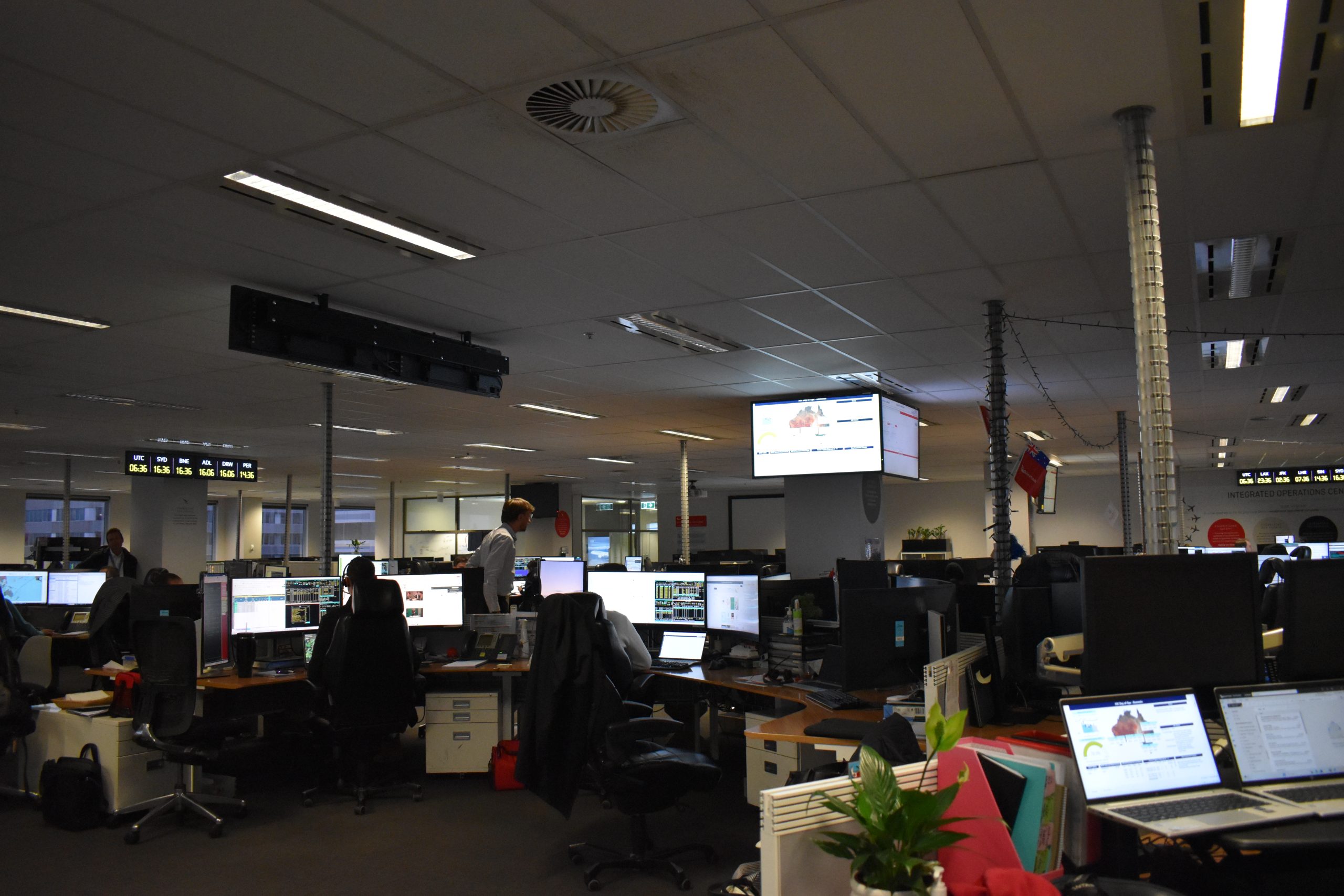
- Qantas’ Integrated Operations Centre at its headquarters. (Photo: AirlineGeeks | Joey Gerardi)
(AG): More so with the international flights, how do you plan, God forbid, if a diversion is required, whether it’s medical or mechanical, how do you plan those diversion points, especially on long flights similar to Dallas-Sydney?
(BH): This is natural for us, we had a medical diversion in Tuvalu two weeks ago, it’s part and parcel of the nature of operations. So I fly as well, but just, for all of our crews out there, we are constantly looking at what our available airports are along the way. So we’ve set up diversion ports all through the Pacific here, and there aren’t too many, but at each point, we know the capability of the ports, we know the latest port we can go to, and we’re also in constant contact with the aircraft via satcom. So, we are only a phone call away from being able to support them with any event that they might face.
(AG): What does the payload optimization look like specifically for that long flight, like Dallas to Sydney?
(BH): So Dallas to Sydney, we have what we call a payload cap or a seat cap on it, and at the moment we’ve capped the A380. That’s because we haven’t been in there for a little while, and so what we’re doing is just an introductory service to make sure that we can provide a good product, and then we’ll start refining it further as we get more information. We also have a look at a rolling 2- and 12-month, we have a look at the historical forecast, and we can start to map the profiles, and then we’ll start to map the realities and what we’re seeing against those forecasts so that we can maximize the opportunity to bring everybody from the U.S. down to Australia.
(AG): I know we briefly mentioned the diversion points, especially for the A380; there are a lot of airports that can’t handle not only the wingspan, but the weight of that aircraft. How do you kind of plan ahead of time, especially if those airports are particularly far apart?
(BH): So we have teams downstairs that have a look at all of the available airports around the world and their capabilities. For instance, for the A380, you can see Hawaii up there, and you can see the eight [Qantas flight 8] coming out of Dallas now, that’ll swing just south of Hawaii there, so that’s one of the ports that we can go to. We keep going through the middle of the Pacific, Christmas Island, then we come down to Nadi, around about three or four hours away from the east coast of Australia, and that’s our next port, and that can handle an A380. Similarly, if we did go into there, what we can do is we can position flight crew, cabin crew, maybe even an engineer in there whilst that aircraft’s in the air to get ready to receive it and keep people going continuously along to the destination.

- Ben Holland pointing at the live flight map, explaining international flight planning. (Photo: AirlineGeeks | Joey Gerardi)
(AG): What does a typical day look like for you here in the IOC?
(BH): There’s no typical days and that’s one of the things I love about the IOC. It is so dynamic, I can come in the morning, and we might have a cyclone somewhere. We might have a hurricane going through Dallas, or we might have thunderstorms. There is no typical day, but we have a fantastic team of people in here with experience anywhere from just arrived up to 47 years, and they work each and every day to try and get our customers safely and efficiently to the destination.
(AG): One last question, I know you said every day is different. But generally speaking, what is the hardest international route to plan?
(BH): The hardest route at the moment is our services up to Europe. The air corridors from a security point of view are quite restrictive, and so we’ve only got a limited amount of options that we can route the aircraft there, so we’re on a continuous watch. But again, this is just part and parcel of what we do each and every day; we’re on a continuous watch worldwide for risks and how we can best manage them and mitigate them. So essentially and hopefully, you don’t actually know that we’re here in the background doing all of this, you can just hop on board, enjoy the great Qantas service, and come down to Australia.
Wine Tasting
After the interviews, we had a special invitation to take part in a wine tasting event right at the headquarters, which is only attended by Qantas executives, a few high-level frequent flyers, and wine makers, some of whom had wines in this year’s running. We ate some food and even did a little wine tasting of our own, and voted for our favorite. But for those wanting to find out which wines were chosen this year, you’ll have to wait a bit longer as the airline plans to announce them officially in a few months.

- Taking part in our own wine tasting event, right at Qantas’ headquarters. (Photo: AirlineGeeks | Joey Gerardi)
A big thanks to Ben Holland in the IOC for answering my questions, as it’s always so interesting to see how it works behind the scenes, planning these long-haul international routes. I had a wonderful time hearing not only about the IOC from Ben, but talking with Sebastian about Qantas Wine Week as well.
A video account of these interviews, as well as Qantas Wine Week, can be found below.



